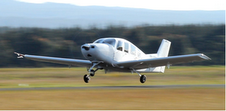India’s CSIR-National Aerospace Laboratories (CSIR-NAL – a constituent laboratory  of the Council for Scientific and Industrial Research), and Mahindra Aerospace (a part of India’s US $12.5 billion Mahindra Group) announced this week the successful maiden flight of their jointly developed C-NM5 aircraft, marking an important milestone in their collaborative aircraft development program.
of the Council for Scientific and Industrial Research), and Mahindra Aerospace (a part of India’s US $12.5 billion Mahindra Group) announced this week the successful maiden flight of their jointly developed C-NM5 aircraft, marking an important milestone in their collaborative aircraft development program.
The program is India’s first public-private partnership in the development of aircraft, and this milestone event is the result of teamwork across three development teams – CSIR-NAL, Mahindra Aerospace and GippsAero (a Mahindra Aerospace subsidiary in Australia).
Engineers from CSIR-NAL and Mahindra Aerospace spent close to three years designing this all-new aircraft using cutting-edge design and analysis tools. The prototype was built over a 10 month period by the rapid prototyping team at GippsAero in their facilities near Melbourne, Australia. Flight testing is being performed at GippsAero by a professionally-trained test pilot supported by GippsAero’s flight test team.
The 45-minute first flight on the 1st of September tested basic handling of the aircraft. Subsequent flights have evaluated aircraft stability and control in different flight regimes. Developmental flight testing and evaluations are continuing, with the ultimate objective of achieving Type Certification in keeping with international regulatory standards, followed by a global sales and marketing programme.
The C-NM5 is a 5-seat all-metal aircraft powered by a Lycoming IO-540 engine, and features non-retractable landing gear and a spacious cabin with large access doors. The cabin interior is reconfigurable to adapt the aircraft to different roles, while simplicity of systems and ease of maintenance are design drivers throughout the aircraft. The C-NM5 thus complements Mahindra Aerospace’s growing family of light utility aircraft that are designed to meet the latest global standards, while operating in environments with limited infrastructure at extremely low costs per seat mile.



